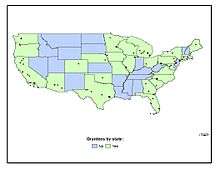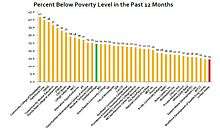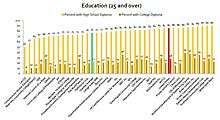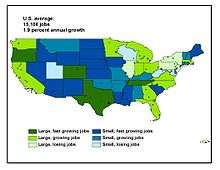Pathways out of Poverty
Pathways Out of Poverty (POP) is an American workforce development program that was established on August 14, 2009, by the Obama administration and funded by the American Recovery and Reinvestment Act (ARRA) of 2009. The Department of Labor's Employment and Training Administration announced POP grantees on January 13, 2010.[1] POP targets individuals living below or near the poverty level to provide them with skills needed to enter the green job market, focusing on the energy efficiency and renewable energy industries. The training programs focus on teaching basic literacy and job readiness skills. Some of the programs also provide supportive assistance with childcare and transportation to overcome barriers to employment.[2]
History
Pathways Out of Poverty is administered by the United States Department of Labor’s Employment and Training Administration. Roughly $150 million is authorized by the ARRA and is granted in amounts from $2 million-$8 million to eight national and 30 local entities for the provision of training and placement services in order “to provide pathways out of poverty and into employment.”[2] The Department of Labor particularly encouraged applicants to focus on serving Public Micro Data Areas (PUMAs) with poverty rates of 15 percent or higher.[2]
Pathways Out of Poverty is part of the "fourth wave" of economic development, which stipulates an environmentally-sustainable approach.[3]
A principal condition of POP is the training of disadvantaged populations for “employment within energy efficiency and renewable energy industries.”[2] This type of employment is sometimes known as "green jobs" or "green-collar" jobs. As mandated by the POP grant, the grantees primarily target low income individuals, veterans, at-risk youth, high school dropouts, the unemployed and underemployed, ex-criminals, and individuals with limited English ability.[2] In addition, some grantees report recruiting public assistance recipients, the homeless, people with disabilities, older workers, women, minorities, and refugees.[2]
Each grantee is free to choose and make partnerships with any organization, including public, private, and not-for-profit. Some examples of partners include community colleges, technical schools, faith-based organizations, community-based organizations, and trade groups.[2]
Grantees
The Department of Labor's Employment and Training Administration announced the 38 national and local organizations that would be receiving grants on January 13, 2010.[1] The grantees for Pathways Out of Poverty (POP) consist of two types: (1) national non-profits that are connected with local organizations; and (2) local public organizations and private non-profits.
There are eight national grantees:
| Organization | Locations | Award Amount | Participants Served |
|---|---|---|---|
| East Harlem Employment Services Inc. | New York, NY; Philadelphia, PA; Hartford, CT; Benton, MI; Flint, MI; Baltimore, MD | $4,728,419 | Unemployed individuals, high school dropouts, and individuals with criminal records |
| Goodwill Industries International (GII) | Atlanta, GA; Austin, TX; Charlotte, NC; Grand Rapids, MI; Phoenix, AZ; Washington, D.C. | $7,303,634 | People with disabilities, chronically unemployed individuals, ex-offenders, older workers, homeless individuals, and high school dropouts |
| Jobs for the Future Inc. (JFF) | Chicago, IL; Detroit, MI; Los Angeles, CA; Milwaukee, WI; Philadelphia, PA | $7,997,936 | Unemployed and disadvantaged individuals |
| MDC Inc. | Charlotte, NC; North Charleston, SC; Orangeburg, Calhoun, and Bamberg Counties, SC; Wise and Dickenson Counties, VA; Scott County, VA | $3,780,816 | Low-wage workers and unemployed individuals |
| National Association of Regional Councils (NARC) | Apache Junction, AZ; Bisbee, AZ; Midland, TX; Odessa, TX; Dayton, OH | $7,994,999 | Limited English proficiency individuals, Native Americans, and ex-offenders |
| National Council of La Raza | San Jose, CA; San Diego, CA; Chicago, IL | $3,063,839 | Low-income and unemployed individuals and individuals with limited English proficiency |
| Opportunities Industrialization Centers of America Inc. | Asheville, NC; Broward County, FL; Phoenix, AZ | $4,900,000 | Unemployed individuals, high school dropouts, and individuals with criminal records |
| PathStone Corp. | Rochester, NY; Scranton, PA; Juana Diaz, Santa Isabel, and Villalba, PR; and Arroyo, Coamo, Guayama, and Salinas, PR | $8,000,000 | Unemployed individuals, high school dropouts, and individuals with criminal records |
There are thirty local grantees:
| Organization | Locations | Award Amount | Participants Served |
|---|---|---|---|
| Alternative Opportunities Inc. | St. Louis, MO | $2,308,200 | High school dropouts, unemployed individuals, ex-offenders, and veterans |
| Better Family Life Inc. (BFL) | St. Louis, MO | $3,305,493 | Unemployed individuals, high school dropouts, and individuals with criminal records |
| Boley Centers Inc. | St. Petersburg, FL | $2,300,678 | Disadvantaged and unemployed urban youth |
| Citrus Levy Marion Regional Workforce Development Board Inc. | Ocala, FL | $2,985,175 | Unemployed workers, low-income adults, high school dropouts, and individuals with a criminal history |
| City of Minneapolis | Minneapolis and St. Paul, MN | $4,000,000 | Individuals living in poverty, veterans, and unemployed young adults who do not have high school diplomas |
| CNY Works Inc. | Syracuse, NY | $3,715,931 | Low income individuals, ex-offenders, disadvantaged young adults, and displaced workers |
| Community College of Philadelphia | Philadelphia, PA | $3,184,428 | Unemployed workers, ex-offenders, and veterans |
| Consortium for Worker Education | Bronx, NY | $4,000,000 | Individuals with limited English proficiency, veterans and eligible spouses, persons with criminal records, and Disconnected Youth and women |
| Eastern Maine Development Corp. | Piscataquis County and Penobscot County, ME | $2,109,088 | Disadvantaged adult job seekers, dislocated workers, returning offenders, public assistance recipients, high school dropouts, and veterans |
| Florida State College at Jacksonville | Duval County, FL | $2,229,642 | Unemployed individuals, high school dropouts, and individuals with criminal records |
| Grand Rapids Community College | Grand Rapids, MI | $4,000,000 | Unemployed workers, high school dropouts, and individuals with criminal records |
| It's My Community Initiative | Oklahoma City, OK | $4,000,000 | Underemployed individuals and ex-offenders |
| Lehigh Valley Workforce Investment Board, Inc. | Allentown, PA | $4,000,000 | At-risk youth, veterans and eligible spouses, and underemployed and unemployed individuals |
| Los Angeles Community College District (LACCD) | Los Angeles, CA, communities of Watts | $4,000,000 | Dislocated, unemployed, underemployed, low-income workers and veterans |
| Mi Casa Resource Center | Denver, CO | $3,633,195 | Unemployed individuals, high school dropouts, individuals with a criminal record, women, and minorities |
| Mott Community College(MCC) | Flint, MI and adjoining suburbs | $3,662,403 | Low-income individuals |
| Mountrie Technical College | Tift County, GA | $3,753,579 | Individuals on probation, high school dropouts, residents with disadvantaged backgrounds, and displaced workers |
| Northern Rural Training and Employment Consortium (NoRTEC) | Butte, CA; Del Norte, Lassen, Modoc, and Siskiyou, CA; Shasta County, CA; Tehama and Trinity, CA | $4,000,000 | High school dropouts, at-risk youth, welfare recipients, individuals with criminal records, unemployed and dislocated workers, and veterans |
| Private Industry Council of Westmoreland/Fayette Inc. | Fayette County, PA | $2,732,719 | Unemployed individuals, high school dropouts, and individuals with criminal records |
| Providence Economic Development Partnership | Providence, RI | $2,489,111 | Ex-offenders and low-literacy individuals |
| Roca Inc. | Chelsea and Revere, MA | $2,398,778 | High-risk youth |
| SER - Jobs for Progress of the Texas Gulf Coast Inc. | Houston, TX | $3,122,554 | High school dropouts, ex-offenders, unemployed individuals, and disadvantaged individuals |
| Southeast Community College Area | Lincoln, NE | $2,331,278 | Unemployed individuals, veterans, high school dropouts, individuals with criminal records, refugees, and immigrants |
| Southwest Housing Solutions Corp. (SWHS) | Southwest Detroit, MI | $4,000,000 | Unemployed individuals, high school dropouts, individuals with a criminal record, and veterans |
| West Hills Community College District | Mendota, Firebaugh, San Joaquin, Huron, Coalinga, Lemoore, Avenal, and the unincorporated communities of Tranquility, Riverdale, Biola, and Five Points in Fresno and Kings Counties, CA | $3,000,000 | Disadvantaged individuals |
| Western Iowa Tech Community College (WITCC) | Woodbury County, IA | $3,999,459 | Dislocated workers, low-income adults, and disconnected youth |
| White Earth Band of Chippewa | Mahnomen, Clearwater, and Becker counties, MN | $3,086,817 | High school dropouts, unemployed individuals, and individuals with criminal records |
| Workforce Development of Seattle-King County | Southeast Seattle, WA | $3,639,530 | High school dropouts, unemployed adults, veterans, previously incarcerated youth and adults, and other disadvantaged individuals - with a specific focus on communities of color, individuals with limited English proficiency, and individuals with disabilities |
| The WorkPlace Inc. | City of Bridgeport, CT | $4,000,000 | High school dropouts, individuals with criminal records, unemployed individuals, and people facing other significant disadvantages |
| Worksystems Inc. | East Multnomah County, OR | $4,000,000 | Native Americans, African-Americans, Latinos, immigrants, veterans, individuals with criminal records, and homeless individuals |
Locations
Pathways out of Poverty (POP) grantees are located in 26 states and the District of Columbia. They are primarily located in major metropolitan areas, but some grantees are located in more rural and smaller metropolitan regions.[2]

The Department of Labor's Employment and Training Administration particularly encouraged applicants to focus on serving Public Micro Data Areas (PUMAs) with poverty rates of 15 percent or higher.[2] Data from the 2009 American Community Survey 1-Year estimates indicates that the PUMAs covered by grantees had an average percentage of inhabitants in poverty that was ten percentage points higher than the national average, at least within the last twelve months.[4]

In addition, on average, PUMAs covered by grantees have inhabitants with lower levels of education, lower levels of health insurance coverage, and lower levels of English fluency.[4] One barrier to economic development in impoverished areas is lack of skills and education possessed by the inhabitants, which is one rationale for workforce development programs.[3]

Training
Pathways out of Poverty (POP) grantees proposed providing a variety of services, including sector-based training for green jobs, remedial education and GED help, "soft skills" training, entrepreneurial training, and supportive services.[2] The primary focus of this program is sector-based: grantees are working backwards from specific job categories to design training and place individuals.[5] However, unlike some sector-based programs, POP grantees are enrolling high school dropouts, ex-offenders, and other "harder-to-employ" individuals, as opposed to recruiting more employable individuals. These individuals may require remedial education and GED instruction, which some POP grantees report providing.[2]
Green Jobs Training
POP grantees are required to train participants for “employment within energy efficiency and renewable energy industries.”[2] Grantees reported training individuals for jobs in the following areas: advanced battery manufacturing, agriculture, forestry, and landscaping, bio-fuel manufacturing and distribution, biofuels, building performance, deconstruction and materials use, energy efficient assessment, energy-efficient building maintenance, energy-efficient building, construction, and retrofit, environmental protection, environmental remediation, recycling, renewable energy and electric power, solar energy, sustainable manufacturing, transportation, waste collection and remediation, water management, and wind energy.[2]
A 2010 report by the Pew Charitable Trust foundation indicates that green jobs or green-collar jobs are starting to make an impact in the U.S. economy. According to this study, green jobs grew about two and a half times faster than job growth in the U.S. economy as a whole between 1998 and 2007.[6] Out of the 125 PUMAs that are served by the 38 local and national POP grantees, 75 are located in states that have an average of more than 15,000 green jobs available as well as an average annual growth rate of 1.03 percent in green jobs for the period from 1998 to 2007. In comparison, the average annual growth rate for green jobs nationwide during this period was 0.91 percent, and the average annual growth rate for all jobs nationwide was 0.4 percent.[7]

Other Training Provided
In order to participate in the program, grantees must provide green jobs training. However, many of the grantees report providing other training and services for their participants in original grant documents. Many participants may need more than green jobs training in order to move out of poverty; "American Recovery and Reinvestment Act of 2009: Pathways Out of Poverty Grants" refers to POP as "integrat[ing] training and supportive services into cohesive programs that will help targeted populations find pathways out of poverty and into economic self-sufficiency."[2] Grantees report providing apprenticeships, basic and "soft skills" training, remedial education/GED services, English to Speakers of Other Languages instruction, literacy instruction, computer training, entrepreneurship training, and supportive and wraparound services.[2] Additionally, grant documents may not encompass the range of services provided by grantees.
Since many grantees report recruiting high school dropouts,[2] remedial education and GED services may be required before recruits are able to participate in green jobs training programs requiring at least high school diplomas. Additionally, several grantees report recruiting individuals with low literacy levels and low levels of English fluency, necessitating the provision of literacy instruction and English to Speakers of Other Languages.
"Soft skills" refers to “dress, language, punctuality, and posture,” as well as other behavioral traits.[8] Some researchers have speculated that lack of these skills forms a greater impediment to employment for disadvantaged individuals than lack of technical skills or education.[3] About seventeen of POP grantees explicitly mentioned helping participants with “basic or soft skills.”[2]
Support and wraparound services could include free childcare, assistance with transportation, and counseling. About sixteen grantees listed providing these types of services, although they did not list specific services provided.[2] Research indicates that providing these types of services as part of a workforce development program can help improve program participation and reduce attrition.[9]
Outcomes
Since grantees were only announced in January 2010, outcomes from this program are not yet fully known. However, grantees listed proposed outcomes in terms of number of participants enrolled, number of individuals to complete training, number of individuals to complete a degree or certificate, and number of individuals to gain employment.[2]
Proposed outcomes from national grantees (in number of individuals):
Proposed outcomes from local grantees (in number of individuals):
| Organization | Enroll | Complete Training | Receive Degree or Certificate | Gain Employment |
|---|---|---|---|---|
| Alternative Opportunities Inc. | 200 | 80% of graduates | ||
| Better Family Life Inc. (BFL) | 900 | 700 | ||
| Boley Centers Inc. | 150 | 125 | ||
| Citrus Levy Marion Regional Workforce Development Board Inc. | 665 | 556 | ||
| City of Minneapolis | 500 | 400 | 300 | |
| CNY Works Inc. | 750 | 366 | 293 | |
| Community College of Philadelphia | 250 | 225 | 203 | |
| Consortium for Worker Education | 425 | 297 | ||
| Eastern Maine Development Corp. | 105 | 90 | ||
| Florida State College at Jacksonville | 390 | 332 | 282 | |
| Grand Rapids Community College | 1,080 | 302 | ||
| It's My Community Initiative | 236 | 200 | ||
| Lehigh Valley Workforce Investment Board, Inc. | 200 | 100 | 75 | |
| Los Angeles Community College District (LACCD) | 925 | 667 | ||
| Mi Casa Resource Center | 500 | 400 | 150 | 50 |
| Mott Community College(MCC) | 200 | 140 | ||
| Mountrie Technical College | 260 | 208 | ||
| Northern Rural Training and Employment Consortium (NoRTEC) | 554 | 420 | 420 | |
| Private Industry Council of Westmoreland/Fayette Inc. | 250 | 120 | ||
| Providence Economic Development Partnership | 300 | 180 | ||
| Roca Inc. | 225 | 140 | ||
| SER - Jobs for Progress of the Texas Gulf Coast Inc. | 300 | 300 | ||
| Southeast Community College Area | 400 | 220 | 180 | 192 |
| Southwest Housing Solutions Corp. (SWHS) | 360 | 310 | ||
| West Hills Community College District | 150 | 126 | ||
| Western Iowa Tech Community College (WITCC) | 300 | 300 | ||
| White Earth Band of Chippewa | 240 | 100 | ||
| Workforce Development of Seattle-King County | 450 | 365 | ||
| The WorkPlace Inc. | 700 | 500 | 350 | |
| Worksystems Inc. | 360 | 300 | 200 | 180 |
References
- "US Department of Labor announces $150 million in 'Pathways Out of Poverty' training grants for green jobs". U.S. Department of Labor.
- "American Recovery and Reinvestment Act of 2009: Pathways Out of Poverty Grants" (PDF). U.S. Department of Labor.
- Blair, John; Michael Carroll (2009). Local Economic Development: Analysis, Practices, and Globalization. Thousand Oaks, CA: Sage.
- U.S. Census Bureau (2009). "American Community Survey 1-Year Estimates". Archived from the original on 2009-06-25.
- Giloth, Robert (November 2000). "Learning from the Field: Economic Growth and Workforce Development in the 1990s". Economic Development Quarterly. 14 (4): 340–359. doi:10.1177/089124240001400402.
- Galbraith, Kate (June 10, 2009). "Study Cites Strong Green Job Growth". The New York Times. Retrieved 10 December 2010.
- Pew Charitable Trust (June 2009). "The Clean Energy Economy; Repowering Jobs, Businesses and Investments across America" (PDF). Archived from the original (PDF) on 2010-12-06.
- Blair, John; Michael Carroll (2009). Local Economic Development: Analysis, Practices, and Globalization. Thousand Oaks, CA: Sage. p. 234.
- Blakely, Edward; Nancy Green Leigh (2010). Planning Local Economic Development: Theory and Practice. Thousand Oaks, CA: Sage.